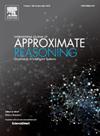不完全多尺度信息系统中改进的循证三向决策
IF 3.2
3区 计算机科学
Q2 COMPUTER SCIENCE, ARTIFICIAL INTELLIGENCE
引用次数: 0
摘要
颗粒计算通过模拟人类的思维过程,为解决复杂的决策问题提供了一个范例。三向决策是颗粒计算的关键组成部分。与传统的决策方法相比,它引入了“延迟决策”,允许对备选方案进行多粒度探索。这个过程逐渐细化了备选方案的粒度,导致了接受和拒绝之间的过渡。此外,现实世界中的数据结构通常是多粒度、多层次和不完整的。与单尺度信息系统相比,不完全多尺度信息系统通过将信息映射到不同层次提供了更丰富的决策基础。此外,根据需求,通过以特定粒度集成来自不同级别的属性信息,它们允许更精确和灵活的决策。因此,本文试图提出一种不完全环境下的三向多尺度决策方法。首先,综合考虑各尺度属性的重要性,建立了不完全多尺度信息系统下基于最佳-最差方法的集成方法;其次,将灰色关联分析计算方法与理想解相似度法排序偏好技术相结合,得到备选方案得分,作为三向决策的条件概率,弥补了指标间相关性导致的欧氏距离失效问题;第三,根据证据理论和增强信念Jensen-Sharma-Mittal散度,融合三向决策阈值,提高三向决策对备选方案的分类效率。最后,利用山西大学“问卷之星”收集的校园环境评价数据集,验证了本文所建立方法的有效性。本文章由计算机程序翻译,如有差异,请以英文原文为准。
Improved evidential three-way decisions in incomplete multi-scale information systems
Granular computing, by simulating human thought processes, provides a paradigm for solving complex decision-making problems. The three-way decision is a key component of granular computing. Compared to traditional decision-making methodologies, it introduces “deferred decision-making”, allowing for multi-granularity exploration of alternatives. This process gradually refines the granularity of alternatives, leading to a transition between acceptance and rejection. Moreover, data structures in the real world are typically multi-granular, multi-level, and incomplete. Compared to single-scale information systems, incomplete multi-scale information systems provide richer decision foundations by mapping information to different levels. Additionally, they allow for more precise and flexible decision-making by integrating attribute information from different levels at a specific granularity, depending on requirements. Therefore, this paper seeks to present a three-way multi-scale decision-making methodology under incomplete environments. First, an integration methodology under incomplete multi-scale information systems by using the best-worst method is built, which comprehensively considers the importance of each scale of attributes. Second, the grey relation analysis calculation is integrated into the technique for order preference by similarity to ideal solution methodology to obtain the score of alternatives, serving as the conditional probability of three-way decisions, which compensates for the problem of Euclidean distance failures due to the correlation among indicators. Third, according to the evidence theory and the enhanced belief Jensen-Sharma-Mittal divergence, the thresholds of three-way decisions are fused, improving the classification efficiency of three-way decisions for alternatives. Finally, the effectiveness of the methodology established in this paper is validated using the campus environment evaluation data set collected through the Questionnaire Star from Shanxi University, China.
求助全文
通过发布文献求助,成功后即可免费获取论文全文。
去求助
来源期刊

International Journal of Approximate Reasoning
工程技术-计算机:人工智能
CiteScore
6.90
自引率
12.80%
发文量
170
审稿时长
67 days
期刊介绍:
The International Journal of Approximate Reasoning is intended to serve as a forum for the treatment of imprecision and uncertainty in Artificial and Computational Intelligence, covering both the foundations of uncertainty theories, and the design of intelligent systems for scientific and engineering applications. It publishes high-quality research papers describing theoretical developments or innovative applications, as well as review articles on topics of general interest.
Relevant topics include, but are not limited to, probabilistic reasoning and Bayesian networks, imprecise probabilities, random sets, belief functions (Dempster-Shafer theory), possibility theory, fuzzy sets, rough sets, decision theory, non-additive measures and integrals, qualitative reasoning about uncertainty, comparative probability orderings, game-theoretic probability, default reasoning, nonstandard logics, argumentation systems, inconsistency tolerant reasoning, elicitation techniques, philosophical foundations and psychological models of uncertain reasoning.
Domains of application for uncertain reasoning systems include risk analysis and assessment, information retrieval and database design, information fusion, machine learning, data and web mining, computer vision, image and signal processing, intelligent data analysis, statistics, multi-agent systems, etc.
 求助内容:
求助内容: 应助结果提醒方式:
应助结果提醒方式:


